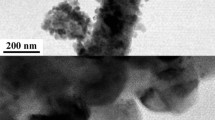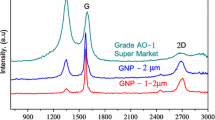Abstract
BiFeO3, GdFeO3 and GdFeO3/graphene nanofibers were successfully fabricated by using an electrospinning technique with a simple single needle. Their structure, size and morphology were investigated by x-ray diffraction, scanning electron microscopy, transmission electron microscopy, energy-dispersive spectroscopy, and selected area electron diffraction. The diameters of the BiFeO3 and GdFeO3 are 60–70 and 80–170 nm, respectively. The electrochemical properties of the BiFeO3, GdFeO3, and GdFeO3/graphene nanofibers for lithium-ion battery applications were evaluated. The results indicate that the GdFeO3/graphene composite shows better electrochemical performance than BiFeO3 and GdFeO3 nanofibers.






Similar content being viewed by others
Data Availability
Data that support the findings of this study are available from the corresponding author upon reasonable request.
References
P. Poizot and F. Dolhem, Clean energy new deal for a sustainable world: from non-CO2 generating energy sources to greener electrochemical storage devices. Energy Environ. Sci. 4, 2003–2019 (2011).
A.M. Mitrašinović, Photovoltaics advancements for transition from renewable to clean energy. Energy 237, 121510 (2021).
C. Liu, F. Li, L.P. Ma, and H.M. Cheng, Advanced materials for energy storage. Adv. Mater. 22, E28–E62 (2010).
T. Kousksou, P. Bruel, A. Jamil, T.E. Rhafiki, and Y. Zeraouli, Energy storage: applications and challenges. Sol. Energy Mater. Sol. Cells 120, 59–80 (2014).
S. Koohi-Fayegh and M.A. Rosen, A review of energy storage types, applications and recent developments. J. Energy Storage 27, 101047 (2020).
M. Li, J. Lu, Z. Chen, and K. Amine, 30 years of lithium-ion batteries. Adv. Mater. 30, 1800561 (2018).
T. Kim, W. Song, D.Y. Son, L.K. Ono, and Y. Qi, Lithium-ion batteries: outlook on present, future, and hybridized technologies. J. Mater. Chem. A. 7, 2942–2964 (2019).
G.E. Blomgren, The development and future of lithium ion batteries. J. Electrochem. Soc. 164, A5019 (2016).
A. Manthiram, A reflection on lithium-ion battery cathode chemistry. Nat. Commun. 11, 1–9 (2020).
P. Roy and S.K. Srivastava, Nanostructured anode materials for lithium ion batteries. J. Mater. Chem. A. 3, 2454–2484 (2015).
C.D.L. Casas and W. Li, A review of application of carbon nanotubes for lithium ion battery anode material. J. Power Sources 208, 74–85 (2012).
A. Mishra, A. Mehta, S. Basu, S.J. Malode, N.P. Shetti, S.S. Shukla, M.N. Nadagouda, and T.M. Aminabhavi, Electrode materials for lithium-ion batteries. Mater. Sci. Energy Technol. 1, 182–187 (2018).
W.E. Teo and S. Ramakrishna, A review on electrospinning design and nanofibre assemblies. Nanotechnology 17, R89 (2006).
X. Peng, A.C. Santulli, E. Sutter, and S.S. Wong, Fabrication and enhanced photocatalytic activity of inorganic core-shell nanofibers produced by coaxial electrospinning. Chem. Sci. 3, 1262–1272 (2012).
W. Xiao, D. Cheng, L. Huang, J. Song, Z. Yang, and Q. Qiao, An integrated separator/anode assembly based on electrospinning technique for advanced lithium-ion batteries. Electrochim. Acta 389, 138776 (2021).
H. Yu, Z. Tian, H. Zhao, Y. Wu, B. Chen, S. Xu, Y. Zhang, and H. Zhao, Electrospinning preparation and electrochemical supercapacitor performance of dendrite-like 3D MgCo2O4/C nanofibers. Ceram. Int. 49, 1203–1213 (2023).
S. Luo, M. Gao, J. Chen, X. Xing, Z. Li, X. Zhou, and W. Wen, BiFeO3 as electrode material for lithium batteries. Mater. Electrochem. Syst. 14, 141–146 (2011).
H. Xia, F. Yan, M.O. Lai, L. Lu, and W. Song, Electrochemical properties of BiFeO3 thin films prepared by pulsed laser deposition. Funct. Mater. Lett. 2, 163–167 (2009).
J. Li, H.M. Dahn, R.J. Sanderson, A.D.W. Todd, and J.R. Dahn, Impact of rare earth additions on transition metal oxides as negative electrodes for lithium-ion batteries. J. Electrochem. Soc. 155, A975–A981 (2008).
Q. Pan, C. Yang, Q. Jia, W. Qi, H. Wei, M. Wang, S. Yang, and B. Cao, Oxygen-deficient BiFeO3-NC nanoflake anodes for flexible battery-superca-pacitor hybrid devices with high voltage and long-term stability. Chem. Eng. J. 397, 125524 (2020).
A. Sarkar and G.G. Khan, Synthesis of BiFeO3 nanoparticle anchored TiO2-BiFeO3 nanoheterostructure and exploring its different electrochemical aspects as electrode. Mater. Today Proc. 5, 10177–10184 (2018).
Acknowledgments
This work was financially supported by the Joint Research Fund Liaoning–Shenyang National Laboratory for Materials Science (Grant No. 20180510045), the Science and Technology Program of Liaoning Province (Grant No. 2020JH2/10700008), the National Natural Science Foundation of China (Grant Nos. 11704056, 11774042, 22075035, and 21776027), and the Fundamental Research Funds for the Central Universities (Grant No. 3132019338).
Author information
Authors and Affiliations
Contributions
YD managed the long-term experiments and processed the data. HY and YZ performed the data analyses and wrote the main manuscript. All other authors contributed to the discussion and revision of the content.
Corresponding authors
Ethics declarations
Conflict of interest
The authors declare no conflicts of interest regarding the content of this article.
Additional information
Publisher's Note
Springer Nature remains neutral with regard to jurisdictional claims in published maps and institutional affiliations.
Rights and permissions
Springer Nature or its licensor (e.g. a society or other partner) holds exclusive rights to this article under a publishing agreement with the author(s) or other rightsholder(s); author self-archiving of the accepted manuscript version of this article is solely governed by the terms of such publishing agreement and applicable law.
About this article
Cite this article
Yu, H., Deng, Y., Chen, B. et al. Electrospinning Preparation and Electrochemical Properties of BiFeO3 and GdFeO3 Nanofibers for their Potential Lithium-Ion Battery Applications. J. Electron. Mater. 52, 3008–3017 (2023). https://doi.org/10.1007/s11664-023-10266-4
Received:
Accepted:
Published:
Issue Date:
DOI: https://doi.org/10.1007/s11664-023-10266-4




